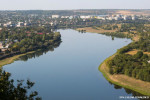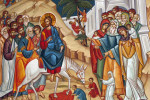
A week before Easter, Christians celebrate Palm Sunday, or Jesus’ Entry into Jerusalem. On this day church-goers attend the Sunday mass and bless willow branches. In Orthodox culture, willow is an indispensable attribute on Palm Sunday, called Florii in Romanian.
“When Jesus entered Jerusalem, they welcomed him as a true lord, with green palm branches. We cannot replicate the gesture of the people of that time and have palm branches or other Middle East plants. For us, the most accessible tree in this period is the willow. It’s already green around the time of Florii. The willow tree is mentioned in many liturgical texts, being a symbol of humbleness, because it always keeps its branches down as a sign of modesty. The Mother of God also weaved willow wreaths. That is why the willow is blessed on Florii. People bring these blessed wreaths home and put them next to icons, keeping them until the following year”, Fr. Ioan Cosoi, adviser at the Metropolis of Bessarabia, told IPN.
“Our ancestors, being initially pagans, had the feast of Floralia dedicated to the goddess of nature and spring. Once baptized, they kept this floral name for the Christian feast as well, in celebration of the green branches and flowers that people had in Jerusalem when they welcomed Jesus”, Fr. Cosoi added.
On Palm Sunday, pilgrimages are made from one church to another or people go to monasteries. Also, people plant flowers in their gardens and tidy up their homes and households. Additionally, Palm Sunday marks the final part of the 40-day Lent.
“The spiritual significance of this feast is that we welcome Jesus into our hearts as our Savior”, says priest Ioan Cosoi. “The Holy Week is coming up next, when every day is an event in the salvation of humanity and the liturgical moment in which Jesus restored our connection with God, the connection of victory over death and over sin”.












